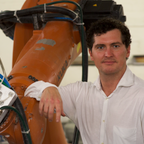Please note as part of IOM3's commitment to sustainability we will not be providing printed copies of the programme. Delegates will be asked to download an electronic copy of the programme from our website or use the conference app.
Simulation for Residual Deformation of Adhesively Bonded Joints Comprising Dissimilar Materials during Curing Process
Residual deformation of adhesively bonded joints of dissimilar materials caused by thermal mismatch of the adherends during the curing process has been investigated analytically and experimentally. Different materials, aluminum alloy and steel, were selected as the adherends of a specimen, and they were bonded with a one-part type epoxy adhesive and cured at high temperature. The specimen bent during the cooling process because of the thermal mismatch between the adherends.
The deformation was simulated by Finite Element Analysis with consideration of curing kinetics for the adhesive, for which various parameters, such as coefficient of thermal expansion, viscoelastic modulus, and constants for Kamal model, were experimentally determined. Subroutine programs were written to perform the FEA using Abaqus. The analytical result showed reasonably good agreement with the data of experiments in which a specimen was cured by holding in a variable temperature circumstance.
Adhesives chemistry – There are many challenges left for the future
Everybody would like to work with universal adhesives covering each requirement for any application. In contrast to that whish, in reality adhesives are increasingly formulated for only one or a few applications. The reason is that each product and production line have different optima for e.g. productivity, mechanical properties, durability and ecological impact. Usually a compromise between different requirements must be found but nevertheless we need to learn how to improve also the single properties. In an ideal case synergistic effects are observed for contradicting properties like increased strength and elasticity. Beside the traditional aspects of adhesives chemistry, more and more ecological aspects must be covered. This includes the utilization of renewable raw materials, the use of carbon dioxide as feed stock, or dedonding on demand. This will be the focus of the contribution beside new fields of applications like bonding in medicine.
Hierarchical toughening of nacre-like composites
Nacre has inspired materials scientists because of its ability to reach remarkable strength and fracture toughness using relatively weak mineral platelets as building blocks. Such platelets are arranged in a brick-and-mortar structure and are interconnected through mineral bridges. In this talk, I will unveil their design principles through the structure-property relationships of model nacre-inspired alumina platelet reinforced composites across three different length scales. Particular attention is given to the role of interconnections between the alumina platelets in the brick-and-mortar architecture and the ductile organic layer that separates the nacreous layers at larger length scales.
Structural features at a coarser length scale were incorporated into the model composites by producing laminates formed by alternating layers of polymer films and brick-and-mortar structures. In this design, the polymer films conceptually mimic the organic layers found between the nacreous layers of the mollusk shell. Using polymers with different strength and toughness levels we discovered that the toughness of the composite can be significantly enhanced by utilizing a polymer film that can absorb the elastic energy stored in the brick-and-mortar layer just before crack initiation. With this simple energetic argument, one can predict the minimum thickness of the polymer layer required to prevent catastrophic failure of the composite. Moreover, the energy needed to fracture these bioinspired laminates can be predicted based on the thickness and fracture toughness of the polymer film.
The nacre-inspired composites reported in this manuscript are a beautiful example of how materials can be structured at multiple length scales to enhance their mechanical behavior. These materials serve not only as a model system to understand some of the design principles of nacre, but also exhibit mechanical properties that rival some of the strongest composite materials available today.
Keep cool or get tough? The thermal properties of adhesives needed to enable structurally bonded EV battery designs.
Most EV batteries are composed of a number of modules which, in turn, contain many lithium cells. The Volumetric Cell To Pack ratio, ‘VCTP’, in traditional cell to module to pack EV batteries is around 40% for prismatic cell based designs. Cutting edge cell to pack designs with prismatic cells, e.g. BYD’s blade design, have been demonstrated to reach 60% VCTP ratios. The latest Tesla batteries are also cell to pack designs and rely on structural adhesives to enable their concept.
However, most structural adhesives have poor thermal conductivity. Conversely, high thermal conductivity adhesives, known as Thermal Interface Materials, have poor mechanical properties. The degradation rates of lithium cells is strongly correlated to cell temperature and temperature gradients. Consequently, thin bond lines using high thermal conductivity adhesives are desirable as this enables faster charging rates and/or longer battery life. However, such bonds have lower mechanical properties and, critically, fracture toughness. As EV batteries need to pass extensive abuse testing on industrial shakers before going onto a prototype vehicle it is desirable to have thicker bonds with high strength and toughness adhesives in a design that relies on structural bonding to transfer loads. The importance of thermal contact resistance of adhesives is such that it should be factored into design decisions from the outset of battery design.
We discuss how we predict cell temperature and temperature gradients in batteries under different charging rates. We compare our predictions to experimental results we obtained by electrically cycling prismatic lithium titanate cells at different charge and discharge rates. The effect of structural adhesives with differing thermal conductivities and thermal contact resistances along with varying the bond line thickness on cell temperature and temperature gradients is presented. Where our modelling approaches start to lose accuracy is also presented. Finally, legislative roadblocks to structurally bonded batteries have been assumed to exist yet new designs are evidence they can be overcome by combining engineering with corporate strategy; a possible strategy is discussed in the context of new battery designs.
Development of high-performance nanocomposite epoxy adhesives using amino-functionalized carbon nanotubes and phase-separated triblock copolymer for aerospace applications
EA9396 epoxy is a prominent adhesive material used in the aerospace industry with a higher viscosity than the standard commercial epoxy systems. While EA9396 has a higher bond strength at ambient temperature, it also offers exceptional strength retention at elevated temperatures due to its tetraglycidyl diaminodiphenylmethane composition. Despite of the higher viscosity, EA9396 can still be utilized in wet layup repairs. However, due to the lower fracture toughness of the epoxy adhesives, debonding/delamination failure may occur in demanding applications. Thus, a high-performance adhesive material cured at room or moderate temperatures with improved bond strength and toughness could outspread the application.
In this study, high-performance EA9396 based nanocomposite adhesive materials were developed using carbon nanotubes (CNTs) and triblock copolymer (SBM) to enhance the lap shear strength, both at room and elevated temperatures. The CNTs were functionalized using novel ultrasonicated ozonolysis followed by grafting branched polyethyleneimine (PEI+OZ-CNTs) or polyamine hardener (H+OZ-CNTs) to produce an amine rich interface that is suitable for chemical reaction with the epoxy resin. The functionalized CNTs were characterized using X-ray photoelectron spectroscopy, infrared spectroscopy, and thermogravimetric analysis to study the chemical reaction of the amine functional groups. The room temperature lap shear tests showed that the optimized nanocomposite adhesives such as 0.5%PEI+OZ-CNTs+10%SBM+EA9396 and 0.5%H+OZ-CNTs+10%SBM+EA9396 resulted in a 40% (50 MPa) and 48% (52.7 MPa) increase in lap shear strength, respectively, when compared to the unmodified epoxy (35.6 MPa). At elevated temperatures, a strength improvement of 20% (26 MPa) was observed for both 0.5%PEI+OZ-CNTs+10%SBM+EA9396 and 0.5%H+OZ-CNTs+10%SBM+EA9396 nanocomposite adhesives. SEM images showed that the PEI and hardener functionalization provided a more uniform CNT distribution in the adhesive, reduced level of CNT pull-out, and enhanced the SBM plastic deformation, which is believed to have enhanced the fracture resistance of the nanocomposite adhesives and contributed to the lap shear strength improvement.









